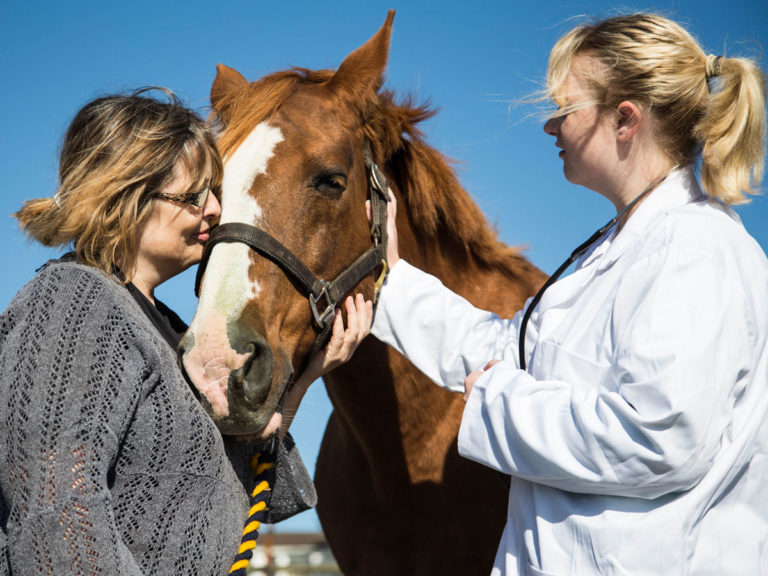
If you have ever spent time in a human hospital, you can relate to the fact that human medical spaces are sealed and carefully maintained building environments. The windows do not open, air is moved quickly and an artificial chill permeates.
Equine hospitals are medical settings, too, and they have many of the same needs for high ventilation rates and aseptic environments. But unlike human hospitals, they are essentially indoor/ outdoor buildings, with large openings to the outside to accommodate horses, equipment and vehicles. This juxtaposition makes the typical equine hospital uniquely challenging to heat, cool and ventilate.
In this article we will outline the basics of HVAC (heating, ventilation and air conditioning) design for equine hospitals. By anticipating the important issues, you will be better prepared to talk with your design team and to make the best decisions for the health of your patients.
An Overview
Equine veterinary hospitals need enhanced air exchange compared to office buildings in order to remove odors, reduce humidity and reduce contaminants such as dust and bacteria that may negatively affect air quality. The problem is that the requirement for increased ventilation often drives the selection of custom equipment rather than “off-the-shelf” equipment. Because of this, the design of these mechanical systems should be undertaken with a clear understanding of the goals that must be achieved.
Before you begin discussing building mechanical design with your team, ask these very important questions:
Does the site have three-phase power? Three-phase (commercial) power is required to run larger mechanical equipment, such as air-handling units that exceed five tons of cooling capacity. If only single-phase (residential) power is available on your site, your design choices will be limited and you might need to make some compromises.
Do you need to fully “condition” (heat and/or cool) every space in the hospital, or can you live with some spaces being covered and ventilated? Developing some ventilated, unconditioned spaces will help tremendously in reducing the overall capacity of your air-handling systems. The answer to this question might depend on your local climate. If your hospital is in Ontario or Florida, working in an unconditioned environment might not be acceptable.
Which areas of your building are like a regular office building? These areas can include reception, conference rooms and offices, restrooms, storage, lab and pharmacy, laundry room, etc. Explain to your team that there is nothing special about the mechanical design of these spaces, other than requirements imposed by building codes. By setting these spaces aside, you can focus on the areas that need specialized solutions.
Defining the Parameters for Specialized Spaces
Specialized spaces include the areas where horses are housed or treated. These areas need to be regarded differently in order to meet acceptable standards for equine health and building sanitation. Because there is very little written about the required design parameters for equine spaces, we have developed our own standards based on the following:
• Experience with veterinary hospital design
• AAEP guidelines to prevent aerosol transmission of pathogens
• Department of Agriculture standards for U.S. states and Canadian provinces. For example, the Ontario Department of Agriculture has written standards for the ventilation of barns.
• Comparisons to accepted standards in human medical hospitals, which have had the benefit of many more research dollars
• A little bit of common sense!
Based on the above, the following is a guideline for use in discussions with your design team. But first, a list of terms that are used in the guideline:
• “ACH” refers to Air Changes per Hour, or the number of times that the volume of air in the room is replaced within one hour.
• “Outside air” refers to the percent of fresh air that is integrated into the air supply system.
• “Pressurization” is a tool for preventing the spread of contaminants in a medical environment. For example, surgery rooms are positively pressurized, meaning that more air is supplied to the room than is removed in order to prevent airborne contaminants from entering the surgical space.
The accompanying chart is reasonable compared to the standard that is applied to specialty small animal hospitals, which typically are designed with more air changes and 100% outside air in specialty medical spaces. We justify a reduction for equine hospitals based on the fact that equine surgery rooms are large spaces, so removing the entire volume of air and replacing it a dozen times per hour is prohibitively expensive in most cases.
However, if you have a large hospital with multiple surgery rooms, or if you specialize in orthopedic surgery, it is best to require 100% outside air in surgery zones and to boost the air changes in the surgery spaces to at least 12 ACH.
One standard is very clear, and this is the need to provide 100% outside air in any space where horses might shed communicable disease or in any space where horses are extremely vulnerable. In other words, it is insupportable to recycle potentially contaminated air into the supply air stream.
In barns where sick horses are frequently housed, it is ideal to provide exhaust separately to each stall via exhaust fans that vent directly to the exterior. If you have all the stalls exiting into the same duct system (ganging), there could be a problem with all the ductwork becoming contaminated with salmonella and other pathogens. If something dangerous breaks out in one stall, it is better to sanitize or replace one piece of equipment rather than wondering where pathogens might have spread.
Considerations for Energy Savings
You will likely discover through the process of working with your design team that medical-quality air-handling systems are expensive and energy consuming. Fortunately, there are a number of strategies from low-tech to high-tech that can reduce the life cycle costs of your building mechanical systems.
• Let Nature Work for You: If your climate allows, design exam spaces to open to the exterior in nice weather to bring in fresh air naturally. During these times, your air-handling systems should be operating in ventilation-only mode (like a whole house fan), or they can be shut down entirely if breezes are sufficient.
• Use Setbacks: Let your design team know what the operating hours are for each area of your building. For example, if your ICU is rarely occupied, it might be possible to provide an “unoccupied setback” for this zone that reduces air flow when the room is not in use. Unoccupied and night setbacks are regularly used by mechanical engineers to reduce the overall energy usage of a building.
• Use Evaporative Cooling in Dry Climates: If you live in a dry climate, it might be possible to incorporate evaporative cooling to reduce utility costs. Modern indirect/direct evaporative cooling equipment combines the energy-saving technology of evaporative cooling with strategies to reduce the introduction of humidity into the building.
• Consider Energy Recovery Equipment: It is very common to include energy recovery technology in commercial and medical buildings, and in some cases it is required by building codes. Energy recovery equipment preconditions the incoming air stream with the energy of the outgoing air without crossing the air streams. Talk to your mechanical engineer to discuss the various technologies that are available and to decide whether energy recovery equipment is right for your project. Typically, energy recovery equipment pays for itself quickly within the overall lifetime of a building.
Take-Home Message
An equine hospital is a complex building that typically incorporates indoor/ outdoor barnlike spaces, carefully controlled medical spaces, and office and support areas. With this introduction, you will be able to discuss the unique HVAC requirements of the equine patient and medical areas specifically, which will benefit you during the design of your project. Ultimately, the design that your team develops will need to balance the limitations of your site, your budget and your local climate with the recommended best practices for heating, cooling and ventilating equine medical spaces.

*Additional cooling or heating might need to be supplied in equine housing areas for special cases. Keep in mind that the best practice is to keep barn areas as close to the outside temperature as possible without freezing the plumbing in the winter or overheating the horses in the summer.
Heather E. Lewis joined Animal Arts in August 2000 and has been a principal in the firm since 2004. Her primary area of expertise is the design and management of equine and large animal projects. Examples of Heather’s equine and large animal work include master planning for Woodside Equine Clinic in Ashland, Virginia, the repurposing of existing buildings for equine hospitals in Kamuela, Hawaii, and Murrysville, Pennsylvania, and freestanding equine facilities such as Evergreen Equine in Reading, Vermont. Lewis has worked on the design of two significant equine facilities in Australia, including the Equine Health Centre for the University of Adelaide, Roseworthy Campus in Roseworthy, South Australia. She recently completed work on the renovation of the equine adoption center for the Harmony Equine Center for the Dumb Friends League in Franktown, Colorado. You can get more information at AnimalArts.biz.








